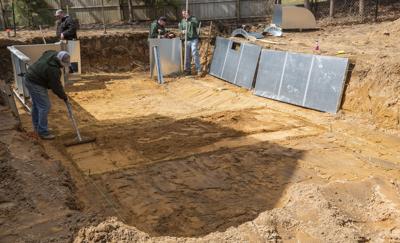After spending much of 2020 hunkered down amid COVID-19 restrictions, anxious but antsy consumers decided 2021 was the year to turbocharge their staycations by investing in backyard oases.
Demand for in-ground swimming pools skyrocketed, pushing installations out through 2021 and in some cases into 2022.
Now? Consumers are watching cautiously from the sidelines, eager to dip a toe but remaining pat as the recent crushing runup in inflation and interest rates continues to abate.
Waiting with them is Latham Group, the locally headquartered manufacturer of residential pools that dealers sell and assemble at customers’ homes. It went public in 2021 with big plans to corner the U.S. market for fiberglass pools, versus legacy vinyl-lined or concrete, and rode the staycation wave.
But the company had to dial back beginning in late 2022 as demand softened, closing three smaller manufacturing plants and five warehouses and cutting staff over the next year.
2023 saw “the largest demand contraction I’ve seen in my 15 years in the pool business,” CEO Scott Rajeski told analysts on a conference call in November. At the same time, though, “interest in pool ownership is as high as we’ve ever seen,” he said.
Rajeski predicted more of the same last week as Latham Group released full 2023 results, pointing out that “lower interest rates and improved consumer confidence levels are not likely to occur in time to benefit the 2024 pool-buying season.”
As a result, he said on the fourth-quarter conference call, “we are managing to an approximate 15% decline in new pool starts.”
A slide deck that accompanied the presentation showed new in-ground residential pool installations in the U.S. at 117,000 in 2021 – a recent peak – then dropping to an estimated 70,000 last year, which was even below 2019’s total of 78,000.
Meantime, the share of fiberglass pools installed has climbed steadily, rising six percentage points between 2019 and 2023 to an estimated 22% of all new U.S. pools, according to the slides.
Latham Group touts fiberglass pools as having lower upfront costs than concrete, with ongoing ownership savings over time. Installation also can occur more quickly, it says.
Company sales totaled $566.5 million last year, down from $695.7 million in 2022. Sales were off 23% for in-ground pools, according to the company; sales for vinyl liners and pool covers were also down from a year earlier but not by as much.
Latham Group offered guidance of $490 million to $520 million on 2024 sales.
Despite the belt-tightening in plants and personnel, 2023 saw ribbon cuttings at new fiberglass pool manufacturing facilities: one acquired in Oklahoma and one built from scratch in Ontario, Canada.
“[Y]ou can expect Latham [Group] to continue to reduce structural costs, while maintaining investments in future growth and capability, so that we are positioned to rapidly capture share as pool starts increase, which we anticipate will occur in 2025,” Rajeski said on the conference call.









